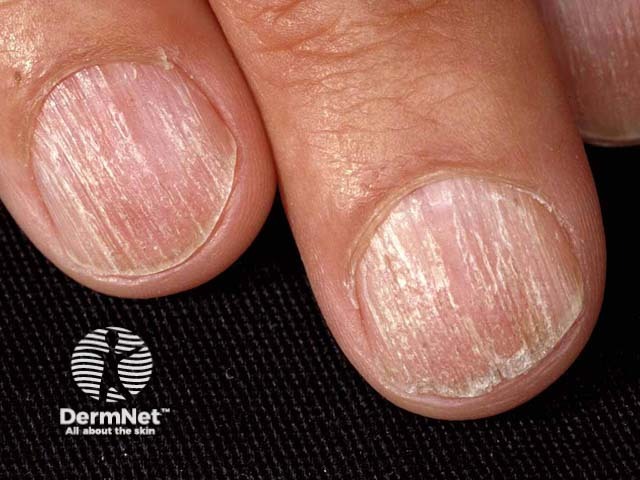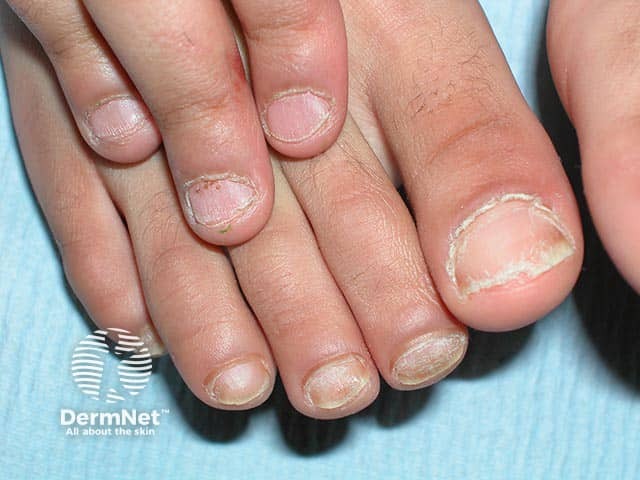Main menu
Common skin conditions

NEWS
Join DermNet PRO
Read more
Quick links
Trachyonychia — extra information
Trachyonychia
Last reviewed: September 2023
Author(s): Szu-Wen Chen, The University of Auckland; and Honorary Associate Professor Paul Jarrett, Dermatologist, Middlemore Hospital and Department of Medicine, The University of Auckland, Auckland, New Zealand (2023)
Previous contributors: Vanessa Ngan, Staff Writer (2006)
Reviewing dermatologist: Dr Ian Coulson
Edited by the DermNet content department
Introduction
Demographics
Causes
Clinical features
Variation of skin types
Complications
Diagnosis
Differential diagnoses
Treatment
Prevention
Outcome
What is trachyonychia?
Trachyonychia is characterised by brittle nails that show diffuse longitudinal ridging and can be accompanied by pitting, loss of lustre, or a roughened nail plate.
Trachyonychia, also known as ‘rough nails’ or ‘sandpaper nails’, can involve any number of nails. Twenty-nail dystrophy refers to trachyonychia that affects all 20 nails.

Opaque trachyonychia - there is opacity and longitudinal ridging

Shiny trachyonychia - the plate is bright and shiny (TND-patient2)

Trachyonychia due to 20 nail dystrophy - all of the nails were affected
Who gets trachyonychia?
Trachyonychia can occur in individuals of all ages, but is predominantly seen in children and young adults, with the peak incidence occurring between 3–12 years of age. It has been reported in both males and females, without a significant gender predilection.
Rare familial cases are described (autosomal dominant) and in identical twins.
What causes trachyonychia?
The pathogenesis of trachyonychia remains unclear. It is hypothesised that inflammation within the nail matrix is involved in the development of the disease, and the extent of inflammatory activity is believed to influence disease severity.
It can be idiopathic or associated with:
- Alopecia areata/alopecia universalis
- Lichen planus
- Psoriasis
- Ichthyosis vulgaris
- Atopic dermatitis
- Vitiligo.
What are the clinical features of trachyonychia?
Trachyonychia can be classified into two subtypes based on clinical presentation and severity.
Opaque trachyonychia:
- More severe and more common
- Associated with persistent and diffuse inflammation in nail matrix
- Thin, brittle, and ‘sandpaper-like’ appearance, characterised by prominent longitudinal ridging and frequent onychoschizia (nail splitting)
- Hyperkeratotic, irregular cuticles with superficial scaling.
Shiny trachyonychia:
- Mild manifestation with multifocal and intermittent inflammation in the nail matrix
- Nail plates maintain lustre, presenting with numerous small geometric pits arranged in a pattern that creates longitudinal ridges and reflects light.
In both opaque and shiny trachyonychia, koilonychia (spoon-shaped nails) can be observed, and fingernails are more commonly involved than toenails.
In twenty-nail dystrophy, all nails are affected.
The severity of the condition can vary between different nails within the same patient, and it is possible for both opaque and shiny varieties to coexist.
How do clinical features vary in differing types of skin?
There are no variations in the clinical features of trachyonychia between patients with different skin colours.
What are the complications of trachyonychia?
- Psychological distress and reduced self-esteem due to nail changes.
- Difficulty with daily function.
How is trachyonychia diagnosed?
Trachyonychia is primarily a clinical diagnosis based on history, full skin examination, and characteristic nail changes. However, some tests can assist in the diagnosis.
- Dermoscopy — distinctive changes include scaling, longitudinal ridging, pitting, involvement of proximal nail plate, involvement of >50% of the proximal nail plate width, onychoschizia, and thickened and ragged cuticles.
- Nail clippings — exclusion of fungal nail infection or associated disorders.
- Nail unit biopsy — not routinely performed. Spongiosis of the nail unit is a typical histological finding in trachyonychia.
What is the differential diagnosis for trachyonychia?
What is the treatment for trachyonychia?
Treatment may not always be necessary as trachyonychia can improve or resolve spontaneously over time in many patients.
General measures
- Observation, reassurance, counselling, and active non-intervention.
- Emollients in opaque trachyonychia to improve the nail surface texture.
- Camouflage with nail polish in shiny trachyonychia to improve appearance.
Specific measures
There is a lack of gold-standard evidence-based approaches due to limited data. Numerous treatment modalities have been trialled in small numbers of patients and responses vary.
Topical therapy:
- Corticosteroids
- Calcipotriol/betamethasone dipropionate ointment
- Fluocinonide/bifonazole cream
- Retinoids (eg, tarazotene gel)
- Keratolytic agents (eg, urea cream)
- Chemotherapy (eg, 5-fluorouracil 5% cream)
- PUVA
- Weekly nail plate dressings once a week with agents such as lactic acid, silicon dioxide, or aluminium acetylacetonate.
Intralesional therapy:
Systemic therapy:
It is not usually justified to exhibit systemic therapy as most patients find this a cosmetic concern only, but if it is severe enough to have functional effects, the agents below have been advocated.
- Corticosteroids
- Oral retinoids
- Ciclosporin
- Biotin
- Hydroxychloroquine
- Janus kinase (JAK) inhibitors (eg, oral tofacitinib).
How do you prevent trachyonychia?
There are no specific preventive measures known for trachyonychia.
What is the outcome for trachyonychia?
Trachyonychia is a benign but chronic condition. Resolving nail abnormalities without treatment can be a gradual process, often spanning several years.
Bibliography
- Baran R, Dupré A, Christol B, et al. L'ongle grésé peladique [Vertical striated sand-papered twenty-nail dystrophy (author's transl)]. Ann Dermatol Venereol. 1978;105(4):387–392. Abstract
- Haber JS, Chairatchaneeboon M, Rubin AI. Trachyonychia: Review and Update on Clinical Aspects, Histology, and Therapy. Skin Appendage Disord. 2017;2(3–4):109–115. doi: 10.1159/000449063. Journal
- Jacobsen AA, Tosti A. Trachyonychia and Twenty-Nail Dystrophy: A Comprehensive Review and Discussion of Diagnostic Accuracy. Skin Appendage Disord. 2016;2(1–2):7–13. doi: 10.1159/000445544. Journal
- Lim SS, Chamberlain A, Hur K, et al. Dermoscopic Evaluation of Inflammatory Nail Disorders and Their Mimics. Acta Derm Venereol. 2021;101(9):adv00548. doi: 10.2340/00015555-3917. Journal
